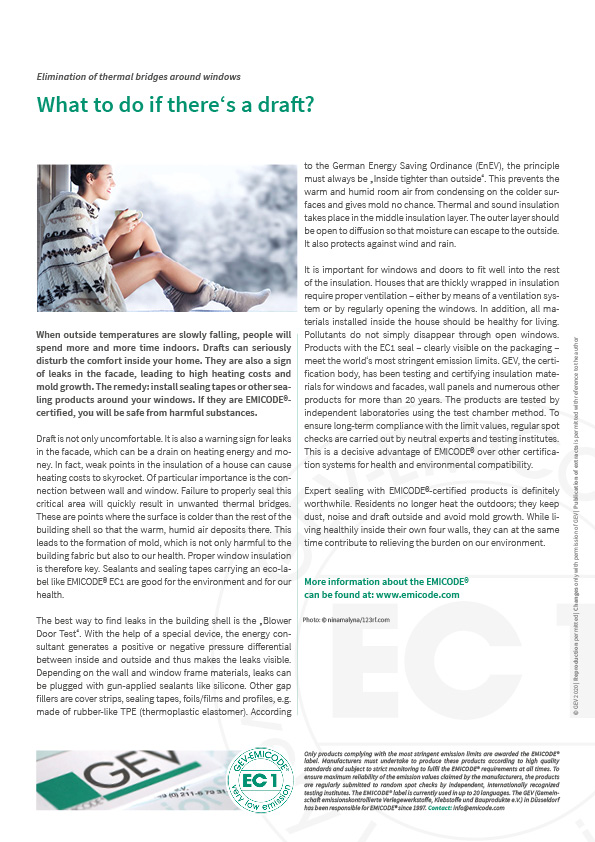What to do if there’s a draft?
Elimination of thermal bridges around windows
Draft is not only uncomfortable. It is also a warning sign for leaks in the facade, which can be a drain on heating energy and money. In fact, weak points in the insulation of a house can cause heating costs to skyrocket. Of particular importance is the connection between wall and window. Failure to properly seal this critical area will quickly result in unwanted thermal bridges. These are points where the surface is colder than the rest of the building shell so that the warm, humid air deposits there. This leads to the formation of mold, which is not only harmful to the building fabric but also to our health. Proper window insulation is therefore key. Sealants and sealing tapes carrying an eco-label like EMICODE® EC1 are good for the environment and for our health.
The best way to find leaks in the building shell is the “Blower Door Test”. With the help of a special device, the energy consultant generates a positive or negative pressure differential between inside and outside and thus makes the leaks visible. Depending on the wall and window frame materials, leaks can be plugged with gun-applied sealants like silicone. Other gap fillers are cover strips, sealing tapes, foils/films and profiles, e.g. made of rubber-like TPE (thermoplastic elastomer). According to the German Energy Saving Ordinance (EnEV), the principle must always be “Inside tighter than outside”. This prevents the warm and humid room air from condensing on the colder surfaces and gives mold no chance. Thermal and sound insulation takes place in the middle insulation layer. The outer layer should be open to diffusion so that moisture can escape to the outside. It also protects against wind and rain.
It is important for windows and doors to fit well into the rest of the insulation. Houses that are thickly wrapped in insulation require proper ventilation – either by means of a ventilation system or by regularly opening the windows. In addition, all materials installed inside the house should be healthy for living. Pollutants do not simply disappear through open windows. Products with the EC1 seal – clearly visible on the packaging – meet the world’s most stringent emission limits. GEV, the certification body, has been testing and certifying insulation materials for windows and facades, wall panels and numerous other products for more than 20 years. The products are tested by independent laboratories using the test chamber method. To ensure long-term compliance with the limit values, regular spot checks are carried out by neutral experts and testing institutes. This is a decisive advantage of EMICODE® over other certification systems for health and environmental compatibility.
Expert sealing with EMICODE®-certified products is definitely worthwhile. Residents no longer heat the outdoors; they keep dust, noise and draft outside and avoid mold growth. While living healthily inside their own four walls, they can at the same time contribute to relieving the burden on our environment.

Photo: ©ninamalyna/123rf.com
When outside temperatures are slowly falling, people will spend more and more time indoors. Drafts can seriously disturb the comfort inside your home. They are also a sign of leaks in the facade, leading to high heating costs and mold growth. The remedy: install sealing tapes or other sealing products around your windows. If they are EMICODE®-certified, you will be safe from harmful substances.

Do You Have Questions?
If you have questions about specific topics or if you would like to contact us for any other reason, feel free to contact us by phone, fax or e‑mail.
Phone: +49 211 / 67931–20
Fax: +49 211 / 67931–33
info@emicode.com
Share article on Social Media:
